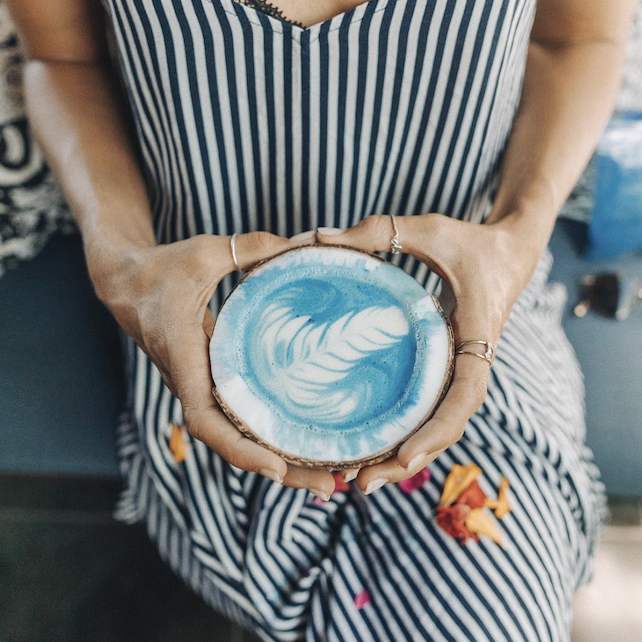Blue Matcha: Benefits, Taste, Preparation, Price, Side Effects

Whether you are a tea lover or just like to try it all, this vibrant and intriguing blue matcha powdered tea has to be on your list.
According to some matcha market projections, this market will witness a CAGR of 9.44% in the next five years.
In this article, you will discover the origins of trendy blue matcha, explore its taste profile, and discuss its pricing and availability. Highlight its health benefits, and learn its versatile culinary uses. So grab your cup of tea and embark on this flavorful journey!
What is Blue Matcha?

Also known as butterfly pea flower tea, a type of herbal tea made from the flowers of the Clitoria ternatea plant. While it shares the name “matcha” with traditional green matcha, blue matcha has no connections with Camellia sinensis plant. This delightful tea gets its name from its stunning blue hue, which can infuse a touch of magic into your tea-drinking experience.
Blue Matcha vs Green Matcha
While shares some similarities with green matcha in terms of its powder form, preparation, and ceremonial use, the two teas differ in their taste, appearance, and nutritional properties. Green matcha is known for its vibrant green color, earthy flavor, and high content of antioxidants, while blue matcha offers a distinct visual appeal and a milder, floral taste.
Taste of Blue Matcha
Delights the taste buds with its delicate, subtly sweet flavor. It has floral notes reminiscent of jasmine or hibiscus, making it a refreshing choice for tea enthusiasts seeking a lighter alternative to traditional teas. The mild taste allows for versatile culinary creations and lends itself well to various flavor pairings.
Versatility
One of the appealing aspects is its versatility. While it can be enjoyed on its own as a soothing cup of tea, it can also be used as a natural food coloring agent, adding an eye-catching blue hue to a variety of culinary creations. The versatility of blue matcha opens up a world of creative possibilities, making it a favorite among adventurous home cooks and professional chefs alike.
Pricing and Availability
The price can vary depending on several factors, including the quality of the flowers used, the processing methods, and the brand. Generally, higher-quality butterfly pea flower tea will command a higher price due to the care taken during the cultivation and production process. It is essential to choose reputable sellers to ensure the authenticity and quality of the product.
Where to Buy Blue Matcha Powder?
Blue matcha is becoming increasingly popular, and it is now more accessible than ever. It can be found in specialty tea shops, health food stores, and online retailers. When purchasing, it is advisable to read customer reviews, check for certifications, and opt for organic options whenever possible.

How to Prepare Blue Matcha?
Brewing this beverage is a simple process that requires hot water and a whisk or frother. Start by heating water to the desired temperature (around 175°F), then add a teaspoon of blue matcha powder to a bowl.
Slowly pour the hot water over the powder while whisking vigorously to create a frothy consistency. Once fully whisked, pour the blue matcha into a cup or mug, and it’s ready to be enjoyed. For serving suggestions, consider adding a touch of honey or a splash of almond milk for a delightful twist.
Health Benefits of Blue Matcha

Antioxidant Power
Like its green counterpart, blue matcha benefits are various. It is rich in antioxidants (not proven yet), which help combat oxidative stress and protect the body against free radicals. These potent compounds are known for their potential to reduce the risk of chronic diseases and support overall well-being.
Promotes Relaxation
Contains natural compounds that have calming properties, promoting relaxation and relieving stress. Sipping on a cup can provide a soothing experience, making it an ideal choice for those looking for a moment of tranquility.
Boosts Cognitive Function
The presence of certain bioactive compounds, such as flavonoids, has been linked to improved cognitive function. Regular consumption of blue matcha may support brain health, memory, and focus, making it an excellent choice for those seeking a mental boost.
Culinary Uses
Beverages
Blue powder can be useful in creating a range of refreshing beverages. For example, you can be brewed it as a hot tea, chill it for iced tea, or mix it with other ingredients to make delightful tea-based cocktails and mocktails. Its captivating blue color adds a visual appeal to any drink, making it a popular choice for Instagram-worthy creations.
Desserts
Also, it can be incorporated into a variety of desserts, infusing them with a beautiful blue hue and a delicate flavor. From cakes and cookies to ice creams and puddings, the possibilities are endless. The use of butterfly pea flower tea powder allows for stunning dessert presentations that are sure to impress both visually and gastronomically.
Potential Side Effects
While butterfly pea flower tea is generally considered safe for consumption, it’s essential to be aware of potential side effects. Some individuals may be allergic or sensitive to the ingredients present in blue matcha, especially if they have a history of allergies to plants or flowers. Additionally, blue matcha does contain a small amount of caffeine, which can cause adverse effects in those sensitive to stimulants.
It’s crucial to consume blue matcha in moderation and be mindful of personal tolerance levels.
In Summary
With its mesmerizing blue hue, delightful taste, and numerous health benefits, this beverage holds the attention of tea enthusiasts and culinary explorers.
Whether you are looking to expand your tea collection, add a touch of natural color to your recipes, or simply enjoy a moment of tranquility, blue matcha offers a unique and enticing experience. So why not give this captivating tea a try and indulge in its vibrant flavors and benefits?
FAQs
Does blue matcha contain caffeine?
No, blue matcha is caffeine-free, making it a suitable choice for individuals who are sensitive to caffeine or prefer to avoid it.
Can I mix blue matcha with green matcha?
Absolutely! Combining blue matcha and green matcha can create a visually stunning and flavorful tea blend. Experiment with different ratios to find your preferred balance.
Are there any side effects of consuming blue matcha?
When consumed in moderation, it is generally safe. However, some individuals may experience mild digestive discomfort. If you have any specific health concerns, it is always best to consult with a healthcare professional.
Can blue matcha be used in savory dishes?
While it is commonly used in sweet dishes, it can also be incorporated into certain savory recipes for a unique twist. It pairs well with seafood, rice dishes, and sauces.
Can blue matcha be used as a natural food coloring alternative?
Absolutely! The vibrant blue color of Pea Butterfly tea makes it a fantastic natural food coloring option for various recipes. It can be used to add a pop of color to cakes, frostings, smoothies, and more.

